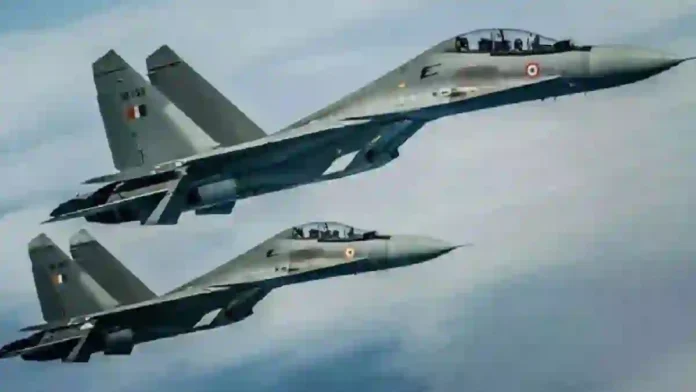Hindustan Aeronautics Limited (HAL) has successfully manufactured and delivered the first AL-31FP engine to the Indian Air Force for their Su-30MKI fighter jets, according to a new contract that calls for the production of 240 engines. This initial engine, built at the Sukhoi Engine Division plant in Odisha, was handed over to the Air Force, as reported by TASS. The contract, valued at $3.1 billion, was finalized on September 9, 2024, and outlines an eight-year timeline for full production.
The Indian Ministry of Defence highlighted this achievement as a testament to HAL’s expertise in aircraft engine production and its dedication to advancing the Indian Air Force’s capabilities with cutting-edge technology. The Sukhoi Engine Division plant has incorporated modern technologies and developed infrastructure that aligns with global standards.
To fully meet the requirements of the Indian Air Force, a total of 950 new engines are needed for the Su-30MKI fleet. Upgrading these fighters with new, Russian-licensed engines is part of a broader modernization effort aimed at advancing them to fifth-generation standards. This upgrade will extend their operational life to 2055 and provide them with the latest radars, avionics, integrated drone systems, and long-range weaponry, including Astra air-to-air missiles boasting a 350 km range.
The production of the first license-built engine for the Su-30MKI marks a significant achievement for Indian industry, potentially setting the stage for an ambitious deal Russia aims to secure. The deal in question involves new fighters for India. According to VZGLYAD, Russia and India are negotiating to increase the licensed production of Su-30MKI fighters by 50 additional units.
These negotiations are part of the long-standing military partnership between Russia and India. In September 2023, India approved the acquisition of 12 new Su-30MKI fighters to be produced under license at Hindustan Aeronautics Limited (HAL). These jets will feature Indian-made avionics and weapon systems. The approximately $1.33 billion deal underscores the ongoing collaboration between the two nations, even amid international sanctions on Russia.
Simultaneously, there are discussions about jointly producing 50 new Su-30 aircraft for both India and potential export markets. Russia is offering technical kits for licensed assembly in India, aiming to modernize and expand their existing joint projects.
These discussions aren’t just about supplies; they also touch on potentially upgrading India’s Su-30MKI to Russia’s Su-30SM2 standard. This upgrade could significantly enhance performance and combat capabilities, including engine and airframe improvements to bring them closer to the Su-35S‘s standards. There’s also talk about future export opportunities, with Russia encouraging India to join joint projects aimed at the global market.
Russia and India signed a deal for the Su-30MKI’s licensed production back in 2000. The Indian HAL (Hindustan Aeronautics Limited) plant in Nashik has been assembling these aircraft ever since. Initially, the agreement covered 140 fighters, but that number has grown to over 260 over the years. Impressively, more than half of these aircraft’s components are already manufactured in India, with raw materials like titanium blocks and critical components coming from Russia.
The Su-30MKI is a two-seat, multi-role fighter jet designed by Russia for the Indian Air Force (IAF). Classified as a medium-heavy fighter, it measures 21.9 meters in length, 14.7 meters in wingspan, and 6.4 meters in height. The aircraft weighs roughly 18,400 kg when empty, with a maximum take-off weight topping out at 38,800 kg. Its two AL-31FP variable thrust vectoring turbojets generate 122.58 kN of thrust each, providing exceptional manoeuvrability and allowing the jet to execute complex aerial manoeuvres.
The aircraft stands out with its digital flight control system (Fly-by-Wire). This ensures precise control and stability, particularly during high-speed manoeuvres. Modern avionics, including a voice command system and multifunction displays, provide pilots with real-time situational awareness.
One of its key features is advanced electronic countermeasures (ECM) and integrated radar systems like the H011 “Bars” multi-purpose phased array radar. This radar can track up to 15 targets simultaneously and engage up to 4 of them.
The fighter jet is equipped with an array of sensors and weapons control systems. Besides the “Bars” radar, it also includes optical location guidance (IRST) and laser rangefinder systems, which allow the detection and identification of targets both in the air and on the ground without using radar emissions. It’s armed with various missiles, including air-to-air P-77 and P-73, air-to-ground X-29, laser-guided bombs, and anti-ship missiles. Plus, there’s a 30-mm GSh-30-1 gun onboard for close air combat, capable of firing 150 rounds.
With an operational range of roughly 3,000 km without needing aerial refuelling, the aircraft is well-suited for long-range missions across national and international airspaces. If refuelled in flight, this range extends significantly, making it ideal for sustained operations in regional conflicts or defending strategic air territories. The aircraft can carry a hefty armament load of up to 8,000 kg on 12 external suspension points, which means it can handle a variety of missions, from air engagements to ground strikes.
Agencies




